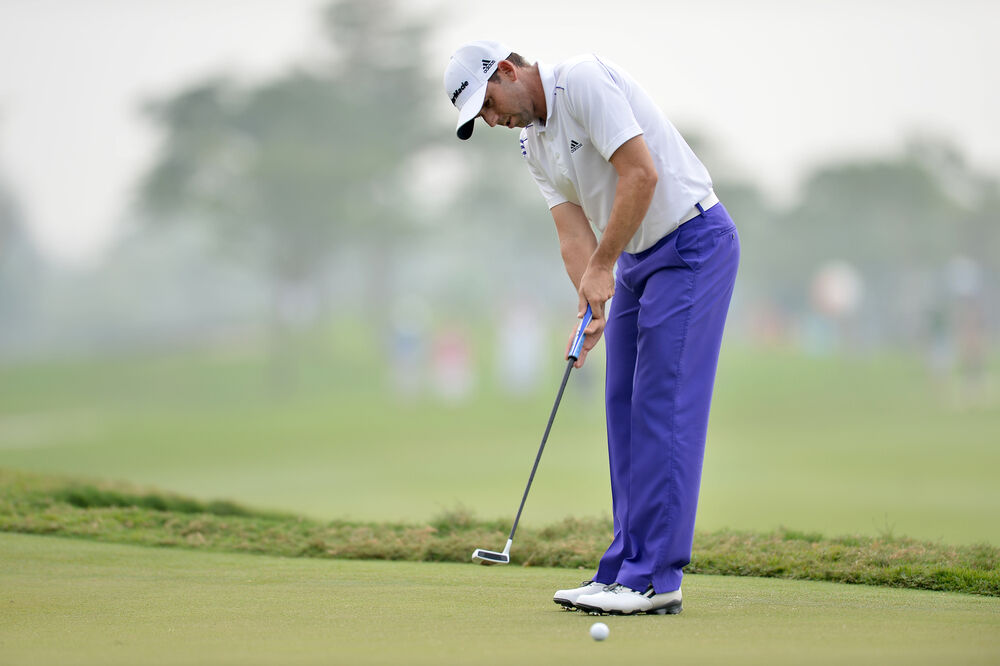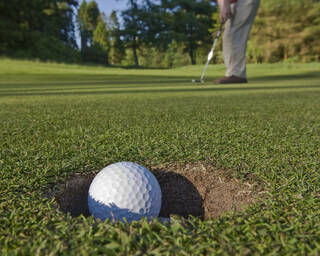How & Why to Use the Claw Putting Grip & Cons to Consider
Considering the claw grip putting style? Here's how to do it, and the pros and cons to consider.

Here's a look a Sergio Garcia's claw putting grip
The claw putting grip has been around for decades. It became popular in the early 2000s when golfers like Chris DiMarco and Sergio Garcia used it on the PGA Tour. Golfers in Asia have been using variations of claw grip putting for many years, and it is said to have originated there.
Today, many recreational and professional golfers use the claw putting grip. It has become a popular alternative to traditional putting grips. While it may not work for everyone, many golfers have found success with claw grip putting and continue to use it to improve their putting.
What Exactly is The Claw Grip?
The claw putting grip is a technique in which a golfer holds the putter with a "claw-like" grip. As with other unconventional putting styles, such as lead hand low, the purpose of the claw grip is to take the trail hand "out of the stroke."
The traditional putting grip style involves placing the lead hand on top with the trail hand on the bottom, similar to how the golfer grips other clubs in their bag. The hands are connected by either interlacing the index finger and pinky or by overlapping the pinky finger of the trail hand on top of the crease between the index and middle fingers of the lead hand.
With the traditional grip style, some golfers find it challenging to control the movement of the trail hand, which can cause the face of the putter head to close too soon, resulting in pulled putts.
The claw grip aims to stabilize the hands and wrists during the putting stroke and eliminate the pull miss that comes with an overactive trail hand. This grip can also be helpful for golfers who struggle with putting issues such as the yips.
How To Use The Claw Grip
There is not one true universal method for the claw grip, but rather, more of a set of guidelines. What I am presenting here are the most basic points that define the claw-style grip.
To use the claw putting grip, follow these steps:
- Begin by gripping the putter in the lifeline of your non-dominant hand (left hand for right-handed golfers) at the top of the grip, like a conventional putting grip. Your palm should face down, and you should wrap your fingers around the grip.
- Next, form a “U” with your thumb and fingers on your dominant hand and grip the club inside that “U.”
- Place your fingers on the putter however they are most comfortable. Some players run their index fingers down the shaft, and some players run all four fingers along the front of the grip. You can do whatever feels best. Your grip should feel comfortable and natural in your hands. Adjust it as needed until it feels right.
- During your putting stroke, it is key to focus on keeping your hands and wrists stable. The claw grip can help prevent unwanted movement and improve your accuracy.
Practice using the claw grip on the practice green until you feel comfortable enough to use it on the course. It’s important to practice putts of various distances to evaluate the effectiveness of a new technique. Make sure you’re comfortable holing a high percentage of short putts and can consistently lag long putts close to the hole.
Remember, there may be better options than the claw grip for some golfers. Experiment with different grips and techniques to find what works best for you.
How To Know If The Claw Might Be Right For You
As a golf instructor, I believe that putting is an essential part of the game, and it can be broken down into four main components: Sound Fundamentals, Speed Control, Green Reading Ability, and Confidence. These four areas are interdependent, and a golfer must excel in all of them to succeed on the green.

How to Putt in Golf: A Complete Guide From Stance to Speed
Proper technique or sound fundamentals do not necessarily mean that a golfer needs to hold the putter in a particular way, especially if it is not conducive to controlling the face at impact or making a good stroke.
If you are not comfortable with your current grip or consistently miss putts due to a lack of face control, experimenting with a new grip could be the solution to improving your success rate on the greens.
There are a few signs that a change to the claw putting grip might be right for you:
- If you struggle with yips or other putting issues, the claw grip can steady your hands and wrists during the putting stroke.
- If you tend to grip the putter too tightly. The claw grip can ease tension and promote a lighter, more relaxed grip.
- If you tend to pull putts, the claw grip can help keep your trail hand more stable during the putting stroke. It reduces unwanted movement and results in a more consistently square club face at impact, which improves accuracy.
Pros and Cons of the Claw Grip
Again, the claw putting grip may not be for everyone, so let’s examine the advantages and disadvantages of the claw style putting grip.
Advantages:
- The claw grip can steady the hands and wrists during the putting stroke, leading to better accuracy, consistency, and, most importantly, more confidence.
- The claw can significantly help golfers who struggle with the yips or other putting issues. My dad can attest to that fact!
- The claw grip can help reduce tension in the hands, wrists, and up through the forearms. It promotes lighter grip pressure. This leads to a smoother putting stroke.
Disadvantages:
- For some golfers, the claw grip might feel uncomfortable or unnatural, and it can take time to get used to.
- Some golfers might find that the grip reduces their feel for the putter. It can also make it harder to judge distance and speed.
- The claw grip can limit wrist movement in the putting stroke. This might not be good for golfers who rely on wrist action for power or control.
Final Thoughts
While I have a blueprint of what I call my "four buckets for putting" as my model to help golfers with their putting, I know full well that this aspect of the game is very individualized. Confidence is one of the most important elements of my four buckets. If you can't feel confident in your ability to roll your ball straight down your target line, it doesn't matter how good your tempo or green reading ability is.
If you struggle with face control in putting and can not start the ball on the intended target line, a grip change could really help you make more putts. Try the claw the next time you are at the course and practicing on the putting green; it could be a game-changer.